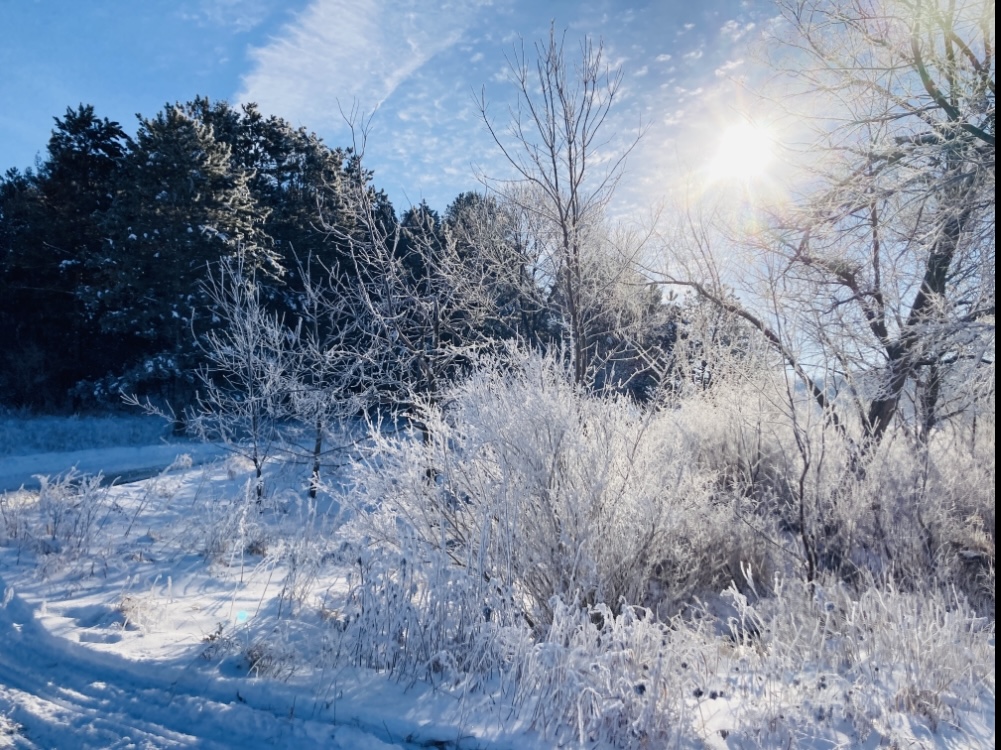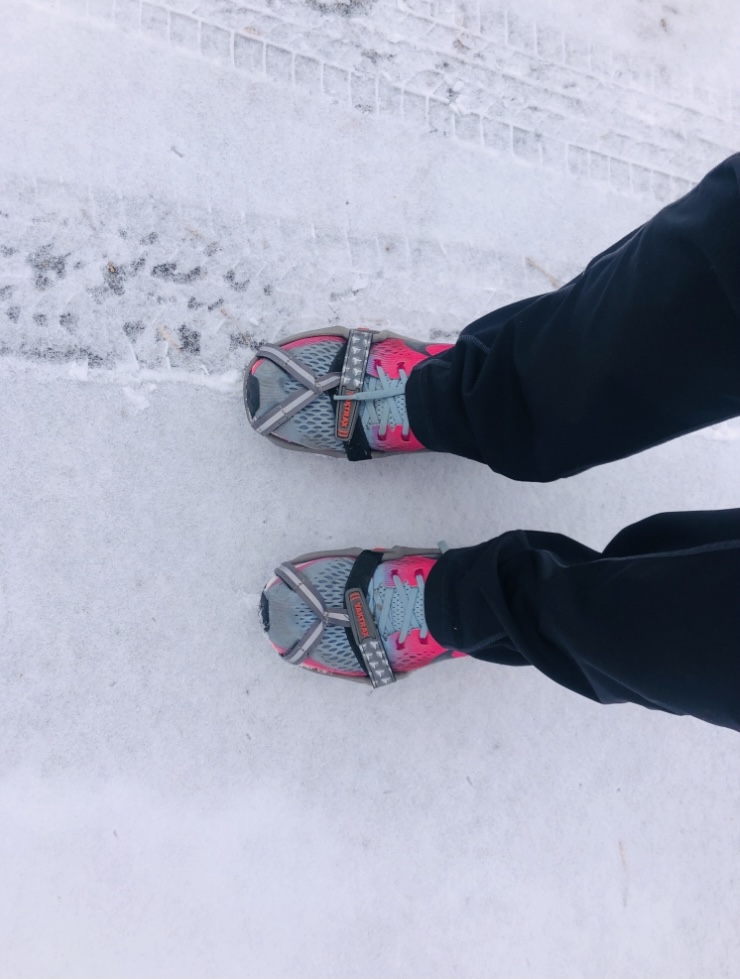15+ Ways to Keep Running in the Snow All Winter Long
Do you struggle to keep running in the snow and cold?
Do you think snow running seems impossible? Have you ever found yourself running on the treadmill because you hate winter running and running on snow?
Trust me- I don’t love winter. However, as a Midwestern runner, I’ve learned over the last 30 years how to run on the snow and actually enjoy it. One winter, we received over 100 inches of snow…which means if I wanted to run, I had to figure out optimal running in snow. Here are my tips- I’d love to hear yours too!
1. When running in snow, run for time, not distance.
Whether the snow is freshly fallen or a few days / weeks old, snow running is not ideal for a speed workout.
In fact, these are the runs to track your effort by time and just ignore the distance.
I don’t even look at the total distance run- I simply go based on time and time alone. The benefit? When the snow melts, you will be surprised by how strong you feel.
Running in snow is almost like running with weights on your feet and you will be light and quick in the future.

2. Choose your surface carefully when running through the snow.
The best places to run on snow are in packed snow, on dirt trails, in the grass (think golf course if it’s allowed), or on the gravel on the side of a rural, safe highway.
These surfaces provide additional traction so you are less apt to slip and slide when running through the snow.
3. Wear appropriate foot gear (I recommend Yaktrax run traction cleats) or special shoes for running on snow and ice.
What are Yaktrax spikes?
Essentially, they are spikes that you wear over your existing winter running shoes that provide ‘spikes’ and extra traction when running in the snow and ice. I usually have one extra pair of running shoes that I keep the Yaktrax run traction cleats on for the winter so they are ready to run when I am.
Personally, I prefer Yaktrax running cleats because of their ease of use and price. I’ve tried a few other over-the-show stabilizers (I loved the Stabilicers but they have been discontinued) with some success. Yaktrax for running are the best investment I’ve found (only $20 on Amazon).
The Yaktrax Run work well for running in packed snow- you will be surprised with the footing you can get, and they do well on ice (not black ice- just skip running on ice as it’s not safe).

How do you use Yaktrax run traction cleats?
The only negative about Yaktrax for running is that you don’t want to wear them when there is only partial snow on the ground.
For example, if you are going on a run in the snow and it’s a mix of snow and dry pavement, it’s not good for Yaktrax. The pavement will wear those Yaktrax down quickly if you pound them away on the bare sidewalk.
Bonus Tip- if you don’t choose Yaktrax for running, pick another brand of winter running cleats for running on ice or snow BUT make sure you select the one designed for running. I’ve found models made for walking don’t provide the same level of stability.
Where to buy Yaktrax for running?
I have purchased a few pairs of Yaktrax run traction cleats over the last three years on Amazon for $20 a pair.
Tip- don’t wait until the winter months to buy them as they tend to creep up in price as demand increases.
Looking for more support with winter running shoes?
Specific winter running shoes are now designed for runners training in winter- snow running shoes may be worth a try if you want to invest a bit more and are in an area with frequent inclement weather.
4. Use sunglasses to protect your eyes from the wind and the glare when running in snow and ice.
Avoid the headache and stress it can cause to have the glare of the sun in your eyes (and don’t mention the dry eyes post-run if you leave your eyes uncovered when winter running). I prefer these sunglasses for running in snow. In general, if it’s cold enough to snow, you probably will want to wear a face mask for running in cold weather. I like this face mask for winter running.
5. Start your winter run going into the wind.
Running in the snow probably means running in the frigid cold.
Always start running into the wind with extra layers on that you can remove as you warm up.
Trust me- you will thank me on the return back.
Yes, that initial swooshing wind is TOUGH but you are tough too and can do it!

6. Think about where you put your key fob and cell phone when heading out for snow running.
If it gets too cold, the battery won’t work and your key fob won’t open your car door upon your return AND your cell phone battery will die quickly (bad combo!).
I typically stick the key fob in my hand inside my glove to keep it warm. I bring an extra glove to wrap around my cell phone. Can you guess that I have had both die on me?
Learn from me and safely enjoy running in the snow and ice versus getting stuck and having to rub your hands together to get that key fob warmed up to go again.
7. Take time to enjoy the magic of snow when running through the snow.
Every winter, the first time I run in snow I think, I just can’t do this anymore! My mind starts to think…it’s too cold to run, too much snow to run, too much too much- but I have to change my mindset and truly appreciate the magic of the snow.
Take your headphones off and listen to the chatter of kids playing in the snow or just the silence of a new snowfall.
Honestly, running through snow and winter is a wonderful time to just feel young again and appreciate the wonder of winter. If you are wondering how to run in snow and not hate it, this is your answer!

8. Appreciate the unique leg workout that running in snow offers.
If you’ve ever run in the sand, running in snow can be comparable. Running in deep snow provides a huge challenge and works pretty much every leg muscle you can imagine. It’s a great way to force your body to lift those knees when running in winter!
If you’ve ever run in the sand, running in snow can be comparable. Running in deep snow provides a huge challenge and works pretty much every leg muscle you can imagine. It’s a great way to force your body to lift those knees when running in winter!
9. Consider a Fartlek type workout for running in snow.

I’ve been running in the snow since I was in my teens. One of the most fun workouts I’ve done through the years is a fartlek in the snow. If the sidewalks are clear and safe, pick up your pace! If it’s a little iffy, slow down and recover-pick it back up when you get some clear ground.
This forces you to pay attention to your surface and also gets your heart rate going. Nothing scientific or timed here- just a good ol’ run in the snow.
10. Make sure to hydrate before and after running in the snow.
It’s easy to forget to hydrate properly when running in the cold, including running in the snow and ice. Just because you don’t feel yourself sweating doesn’t mean your body doesn’t need to replenish fluids. Drink that water throughout the day- best to sip all day long.
11. Alter your form for winter running and snow running.
Because of the potential slippery nature of running on snow, it’s best to slightly alter your form. What exactly does this mean?
Keep your feet a bit lower to the ground than normal and speed up your cadence to the ground (eg, take smaller, more frequent steps). Tighten your core and use it to keep you steady when running in snow.
12. Take extra caution at night when running in snowy conditions.
This might be time to move your run a bit so you are in daylight if it’s feasible in your schedule. Otherwise, make sure to use an excellent headlamp or chestlamp / running lamp and appropriate foot gear.
13. Watch for snowplows and cars if you are running in snow.
Even if you switch your run to daylight, you still need take extra precaution when running on snow- snowplows and cars can NOT see you and often are taking their extra cautions and not expecting to see a runner on the road. Be extra vigilant at all times when running in snow and winter running in general.
14. Drive to a well cleared area for ideal winter running.
Just as the tip above states, you’ve got to look out for potential dangers, whether it’s running on ice, watching for those snowplows, or just uneven ground.
Consider driving to a well-traveled area or a place known for optimal clearing of snow- I’ve found good luck on college campuses or schools in general, mall parking lots (not the most fun, but you can get the run in), certain trails known for well-done trail cleaning, or large corporations. Get creative!
Can’t find a safe, well-cleared area to run in the snow?
Check out your local high school, college, or fitness center to see if they have an indoor track open for the public use.
If you do choose to run on an indoor track, make sure to mix up your directions. Don’t do a few miles running in the same direction as the turns can be tough on your hips.
15. Wear good socks for a run in snow.
There’s nothing worse than super cold feet when running in snow! I have had a few times I can remember when my feet went numb. Learn from my mistakes! I used to wear an extra thin sock layer, but now I’ve found ____ socks- they keep my feet warm even if I choose to ‘plow’ and run in deep snow.
16. Cross train instead of running in snow.
Yep, I said it. As much as I love running- it’s my fave cardio and exercise of choice, you may want to mix it up and hit the local gym for the elliptical or exercise bike.
I’ve even been known to do an indoor workout with stairs and strength training mixed in- yep, in my house up and down the stairs! If windchills are dangerously low or your legs are dead from running through snow, cross training is the smart choice.
17. Give yourself something to look forward to after a run in snow.
Running in snow can seriously challenge you.
These are the days when the bed feels toasty warm and getting up and out for a run often doesn’t have the appeal it has in more seasonable weather.
Visualize something to look forward to.
Maybe it’s the hot shower, a piping hot cup of tea, or just cozying up in a sweatshirt on the couch later to watch a holiday movie knowing you got your workout in earlier.

Let's get out there and run this winter!
Getting outside has such remarkable emotional benefits, even when it’s cold, snowy, and dreary. Heading out and running through the snow can make a dark, wintery day easier to handle and keep you mentally and physically strong. Do you have other recommendations for how to run in snow?
Make sure to listen to our podcast to hear stories from other real runners who are keeping moving after 40 years of age.
Take a picture of yourself before, during, or after your snowy run and share with us on Facebook or tag us on Instagram at #runningwithgrit. Bonus if your eyelashes are frozen and you look like Jack Frost!
